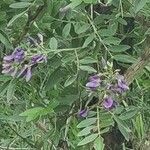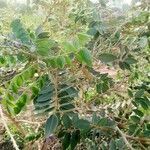Leaves grey or silvery, (5)9–21(29)-foliolate; petiole 1–2 cm long, silky-velvet; rachis 5–8 cm long; leaflets subcoriaceous, ± opposite, 1–6.5(9) × 0.4–3.3 cm, ovate, ovate-elliptic or elliptic to lanceolate, narrowly rounded at the apex, rounded at the base, minutely appressed hairy on both surfaces or glabrescent on upper surface, with 8–10 pairs of lateral nerves; stipules 1–3 mm long, triangular-lanceolate, velvety; petiolules 2 mm long.
Shrub or small tree, up to 5 m high; bark corky, deeply fissured. Leaves pinnate with 6-8 pairs of leaflets, 50-75 mm long; leaflets narrowly ovate, 12-18 x 3-4 mm, apex obtuse, densely silvery pubescent on both surfaces. Flowers in short racemes; calyx densely pubescent; corolla purplish blue; Sep.-Jan.
Standard (1)1.8–2.2 × (1)1.5-1.6 cm, elliptic, emarginate, claw curved, c.3 mm long, inrolled; wing blades 15 × 5 mm, narrowly elliptic, the auricle and claw 2 mm long; blades of keel petals 14 × 5 mm, elliptic-oblanceolate, the auricle 1 mm long and claw 4 mm long.
A shrub or small tree. It grows 2-7 m tall. The flowers are purple. The pod is 8 cm long and 8 mm wide. There are 4-9 seeds. It is constricted between the seeds. The seeds are dark green and kidney shaped.
Flowers lilac, purple, mauve or pink, in pairs at each node of dense terminal velvety pseudoracemes 5–14 cm long; bracts c.0.5 mm long, triangular, persistent; pedicels 0.8–1.8 cm long.
Pod yellow-brown, (4)7–9(12.5) × 0.7–1.1 cm, linear, often constricted between the seeds, velvety, (1)4–10-seeded, indehiscent or eventually dehiscent after a long period.
Young stems velvety silky; bark yellow-brown or pale grey, or striate with ridges grey and fissures white, corky, smooth or fissured.
Calyx tube c.3 mm long, the 3 lower teeth c.3 mm, triangular, the upper pair of teeth almost completely united.
Stamen sheath (1)1.5 cm long, the free parts 3 mm long; upper filament free; anthers 0.5 mm long.
Small tree or many-stemmed deciduous shrub 0.5–7.5(12) m tall.
Ovary linear, c.8-ovuled, velvety; style gently curved.
Seeds dark green, 4(5) × 3 mm, reniform.
A shrub or small bushy tree
Lilac or purplish flowers.



